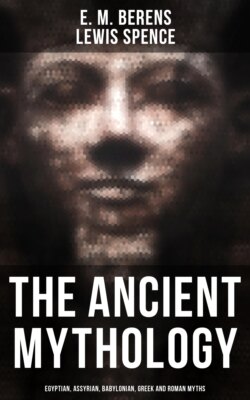Читать книгу The Ancient Mythology: Egyptian, Assyrian, Babylonian, Greek and Roman Myths - Lewis Spence - Страница 66
На сайте Литреса книга снята с продажи.
Ishtar, Tammuz, and Vegetation
ОглавлениеIf it be granted, then, that Ishtar and Tammuz are deities of vegetation, it is possible still further to narrow their sphere by associating them particularly with the corn. Adonis and Aphrodite are connected with the growth of the crops. Ceres, who forbids the corn to spring while her daughter is in the realm of Pluto, is undoubtedly a corn-mother, and Proserpine evidently partakes of the same nature. Osiris was the culture-deity who introduced corn into Egypt. A representation of him in the temple of Isis at Philæ depicts corn-stalks growing out of his dead body—the body of Osiris (the grain) is torn to pieces, scattered through the land, and the pieces buried (or planted) in the earth, when the corn sprouts from it. Moreover, Tammuz himself was cruelly disposed of by his lord, who "ground his bones in a mill, and then scattered them to the wind"—plainly a type of the treatment meted out to the corn. An Arabic writer relates that Tammuz was cruelly killed several times, but that he always came to life again, a story which recalls Robert Burns' John Barleycorn, itself perhaps based on mythical matter.
May not these examples suggest an elucidation on animistic lines? Deities of the Tammuz type appear to symbolize the corn-grain and nothing more—cut down, bruised and beaten, buried in the earth, and finally springing to renewed life. Who, then, are the goddesses, likewise identified with the corn, who seek in the underworld for lover or child, endeavouring with tears to ransom the corn from the dark earth? Are they not the primitive corn-spirits, the indwelling animistic spirits of the standing grain, doomed at the harvest to wander disconsolately through the earth till the sprouting of the corn once more gives them an opportunity to materialize?
The stories of the mutilation and dispersion of the bodies of Tammuz and Osiris, and of the many deaths of the former god, furnish a basis for yet another explanation of the Tammuz myth. Sir James Frazer brings forward the theory that the 'Lamentations' of the ancient Babylonians were intended not for mourning for the decay of vegetation, but to bewail the cruel treatment of the grain at harvest-time, and cites in this connexion the ballad of John Barleycorn, which, we are told, was based on an early English poem, probably itself of mythological origin.
It is, however, most likely that the myth of Tammuz and Ishtar is of a composite nature, as has already been indicated. Possibly a myth of the sun-god and earth-goddess has been superimposed on the early groundwork of the corn-spirit seeking the corn. It would certainly seem that Ishtar in her descent into Aralu typified the earth, shorn of her covering of vegetation. Then in time she might come to symbolize the vegetation itself, or the fertility which produced it, and so would gain new attributes, and new elements would enter into the myths concerning her. Only by regarding her as a composite deity is it possible to reach an understanding of the principles underlying these myths.
